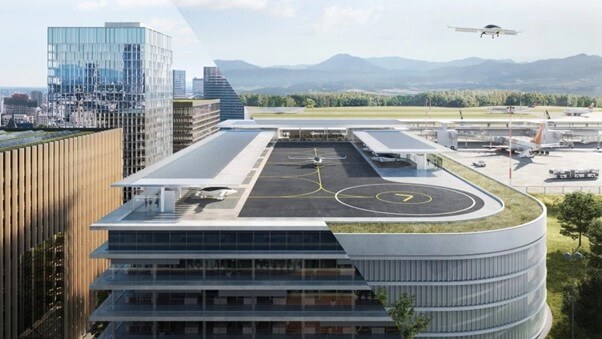Written by Suzanne Walker, Consultant Engineering – Mirragin
Advanced air mobility is coming. It is effectively here, depending on how you define drones versus larger air vehicles. The proposed direction for advanced air mobility, which I will refer to as AAM to save me typing, is to be closer to an upmarket taxi service. No defined check in or security clearance – comparison has also been made to small regional airports. Connected, digitally native, and convenient.
So I wanted to discuss integration with ground transport, not the exciting designs for the take off and landing site themselves, but the necessities like car parking, bike storage, room on the footpath for people to enter without blocking people walking past, space for delivery vehicles to drop things off and turn around. Ground transport as defined at the AAUS conference includes rail, road, and sea, so I will adopt that, but flag that most of my comments will refer mostly to road impacts because of the proposed connections to vertiports (the name for where advanced air mobility such as air taxis will land).
The planned location for being more centralised in urban hubs, and designs requiring less runway space mean requirements for a vertiport are almost definitely going to be different to that of a traditional airport. However, AAM can include freight, as well as short to medium distance passenger travel depending on power type (electric, hydrogen, and hybrid are current options, spanning over 500km), so they aren’t all going to look the same. Plus we are definitely nowhere near an AAM hovering down and parking in a car park on the side of the street to drop you off – even if the technology could do it, the safety considerations are overwhelming.
So a new space, or a changed/added purpose for a space, needs an assessment to understand how it impacts everything else. For the connection aspect, it means a transport engineer considers the requirements of your activity, as well as the impacts that will have on the surrounding environment. For example, if I put an airport next to your house, you are going to have people coming and going, potentially at all hours, people being dropped off, maybe people dragging luggage down the footpath, taxis and ubers lined up. Even if not needing full metropolitan airport provisions, vertiports will still need a range of facilities to support operation, and the passengers, or freight connection, even if the runway equivalent is much smaller, and the space to achieve a noise buffer is considerably lower.
To make a new service work, people need to be able to access it, that is how you get your customers and your return on investment. Think of dead locations in the CBD surrounds that are just too hard to get to, even if they put some attractions there. Docklands for example in Melbourne has definitely struggled.
As a side discussion which I am quite passionate about: accessibility. People at the conference mentioned physical, mental, and invisible disabilities and making sure that this technology is available to everyone, not just those who have managed to use existing transport modes. We also have research into good space design exploring how to make it safer for women and others who might be uncomfortable in low visibility, low light, potentially risky areas. Multi level carports for example are a security concern and add in the need for cameras, lighting etc, it isn’t as simple as just adding vertical layers of parking. That is a whole discussion in itself, but I want to keep mentioning it so that our spaces are designed to be inclusive for all, and not just the typical ‘reference man’.
So three things when we consider integration to a space:
- Traffic generation – How much traffic (this is a generalised term not just vehicles, but includes foot traffic, etc) is the vertiport going to create?
- Traffic distribution – how is the traffic getting to and from the vertiport – roads, public transport connections, what are the common routes being taken?
- Traffic impact – now we know how many people and where they are going, can the existing infrastructure manage that increase? Does it need to be upgraded to meet the required capacity? What are the safety and operational risks if improvements and not made? Who should pay for any required upgrades?
We can make informed estimates about route choice, because of the existing infrastructure layout, but uptake of AAM is still speculative.
So some questions:
- What would need to be offered for you to use AAM?
- Are you comfortable using a new type of aircraft for travel?
- Does it matter to you if there is a pilot?
- How much are you willing to pay?
- Would you be concerned if it was too cheap?
- How long after first commercial flights would you be willing to give it a go?

Suzanne is an experienced engineer with a passion for problem solving, leadership, research informing best practice, and making a positive impact. She has a wide range of multidisciplinary experience, across traffic, rail, major road infrastructure projects, OEM manufacturing, STEM research, and project management. Suzanne started with Mirragin in January 2022 and is now working with drones, autonomous systems, and AI. Suzanne is also undertaking a PhD exploring how community knowledge can be implemented better in engineering projects to improve design outcomes.

